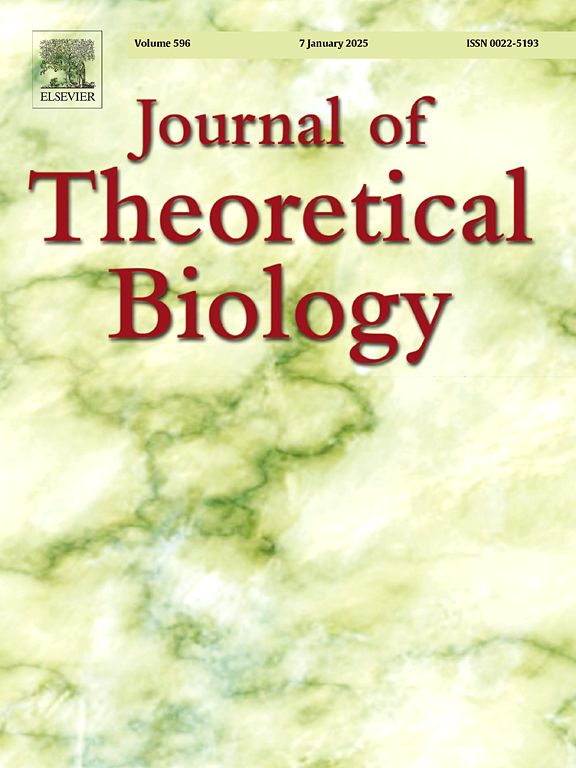捕食者和猎物的进化扼杀了图灵模式
IF 2
4区 数学
Q2 BIOLOGY
引用次数: 0
摘要
捕食者和被捕食者的时空格局在生态学中起着至关重要的作用,生态相互作用影响着它们的形成。特别是,已经提出通过图灵机制驱动时空捕食者-猎物模式的出现。然而,预测的图灵模式并没有表现出在实验和自然界中常见的时间变化。此外,图灵机制认为运动是固定的,即使捕食者和猎物根据彼此的反应调整它们的运动,它们的相互作用影响它们的进化。使用自适应动力学,我证明了运动性的进化阻止了图灵模式的形成,并促进了动态模式的形成,例如捕食者-猎物波。此外,我表明,多种运动表型可以诱导捕食者-猎物振荡,甚至稳定时间动力学,这延长了捕食者-猎物周期的出现,超出了Lotka-Volterra或Rosenzweig-MacArthur模型预测的需要振荡时间动力学的制度。这项工作结合了捕食者-猎物时空模式和运动进化的模型,以解释共同进化的捕食者和猎物的动态时空模式是如何出现和持续的。这一新颖的数学理论具有普遍性,并可推广到生态公共产品博弈等其他生态情境中。本文章由计算机程序翻译,如有差异,请以英文原文为准。

Evolution of predators and prey kills Turing patterns
The spatiotemporal patterns of predators and their prey play a pivotal role in ecology and ecological interactions influence their formation. In particular, motility has been proposed to drive the emergence of spatiotemporal predator-prey patterns via the Turing mechanism. However, the predicted Turing patterns do not exhibit temporal changes that are common in experiments and nature. Moreover, the Turing mechanism treats motility as fixed, even though predators and prey adjust their motility in response to each other and their interactions influence their evolution. Using adaptive dynamics, I prove that the evolution of motility prevents the formation of Turing patterns and promotes the formation of dynamic patterns, such as predator-prey waves. Furthermore, I show that multiple motility phenotypes can induce predator-prey oscillations even for stabilising temporal dynamics, which extends the emergence of predator-prey cycles beyond the regimes predicted by the Lotka–Volterra or Rosenzweig–MacArthur models that require oscillatory temporal dynamics. This work unites models for predator-prey spatiotemporal patterns and evolution of motility to explain how dynamic spatiotemporal patterns of co-evolving predators and prey emerge and persist. The novel mathematical theory is general and extends to other ecological situations, such as ecological public goods games.
求助全文
通过发布文献求助,成功后即可免费获取论文全文。
去求助
来源期刊
CiteScore
4.20
自引率
5.00%
发文量
218
审稿时长
51 days
期刊介绍:
The Journal of Theoretical Biology is the leading forum for theoretical perspectives that give insight into biological processes. It covers a very wide range of topics and is of interest to biologists in many areas of research, including:
• Brain and Neuroscience
• Cancer Growth and Treatment
• Cell Biology
• Developmental Biology
• Ecology
• Evolution
• Immunology,
• Infectious and non-infectious Diseases,
• Mathematical, Computational, Biophysical and Statistical Modeling
• Microbiology, Molecular Biology, and Biochemistry
• Networks and Complex Systems
• Physiology
• Pharmacodynamics
• Animal Behavior and Game Theory
Acceptable papers are those that bear significant importance on the biology per se being presented, and not on the mathematical analysis. Papers that include some data or experimental material bearing on theory will be considered, including those that contain comparative study, statistical data analysis, mathematical proof, computer simulations, experiments, field observations, or even philosophical arguments, which are all methods to support or reject theoretical ideas. However, there should be a concerted effort to make papers intelligible to biologists in the chosen field.

 求助内容:
求助内容: 应助结果提醒方式:
应助结果提醒方式:


